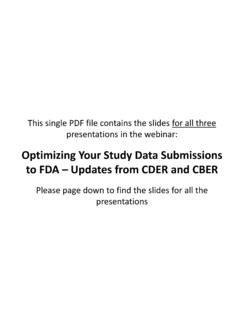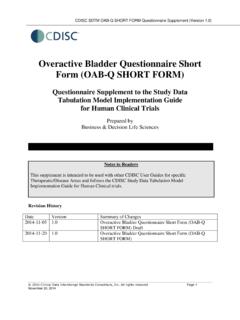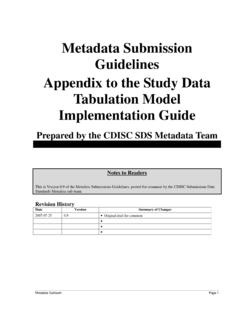Transcription of Paper 1451-2014 Converting Clinical Database to SDTM: The …
1 1 Paper 1451-2014 Converting Clinical Database to SDTM: The SAS Implementation Hong Chen, McDougall Scientific Ltd. ABSTRACT The CDISC study data tabulation model (SDTM) provides a standardized structure and specification for a broad range of human and animal study data in pharmaceutical research, and is widely adopted in the industry for the submission of the Clinical trial data . Because SDTM requires additional variables and datasets that are not normally available in the Clinical Database , further programming is required to convert the Clinical Database into the SDTM datasets. This presentation introduces the concept and general requirements of SDTM, and the different approaches in the SDTM data conversion process.
2 The author discusses Database design considerations, implementation procedures, and SAS macros that can be used to maximize the efficiency of the process. The creation of the metadata and the final STDM dataset validation are also discussed. 2 INTRODUCTION The Clinical data Interchange Standards Consortium (CDISC) study data tabulation model (SDTM) was designed to provide a standardized structure and specification for a broad range of human and animal study data in pharmaceutical research. In medical and biopharmaceutical product development, the CDISC standards can be used to support the electronic acquisition, exchange, submission and archiving of Clinical trials data .
3 The tabulation datasets, which are electronic listings of individual observations that comprise the essential data reported from a Clinical trial, are created based on data captured in the Clinical Database of a study . However, since SDTM requires additional (derived) variables and datasets that are not normally available in the Clinical Database , further programming is required to convert the Clinical Database into the SDTM datasets. The following sections will introduce the concept and general requirements of SDTM, illustrate the different approaches in the SDTM data conversion process, and discuss the SAS implementation considerations in order to maximize the efficiency of the process.
4 SAS programming tips and the creation of the metadata and the final STDM dataset validation will also be discussed. SDTM BASICS SDTM represents the data tabulation datasets that contain data collected in the human and animal studies; these can be thought of as electronic by-subject data listings. The fundamental element of the SDTM is the concept of observations and variables, consisting of information collected during the study . VARIABLES Each SDTM variable, corresponding to a column in a dataset, represents a discrete piece of information or measurement. SDTM classifies all variables into the following five roles: Identifier variables, which identify the study , the subject (individual human or animal) involved in the study , the domain, and the sequence number of the record.
5 Topic variables, which specify the focus of the observation (such as the name of a lab test), and vary according to the type of observation. Timing variables, which describe the timing of an observation (such as start date and end date). Qualifier variables, which include additional illustrative text, or numeric values that describe the results or additional traits of the observation (such as units or descriptive adjectives). Rule variables, which express an algorithm or executable method to define start, end, or looping conditions in the Trial Design model . OBSERVATIONS Each SDTM observation, corresponding to a row in a dataset, is presented as a series of variables.
6 Observations are divided into three general classes: The Interventions class, which captures investigational treatments, therapeutic treatments, and surgical procedures that are intentionally administered to the subject (usually for therapeutic purposes) either as specified by the study protocol ( exposure), or preceding or coincident with the study assessment period ( , concomitant medications). The Events class, which captures planned protocol milestones such as randomization and study completion (disposition), and occurrences or incidents independent of planned study evaluations occurring during the trial ( adverse events) or prior to the trial ( medical history).
7 The Findings class, which captures the observations resulting from planned evaluations to address specific questions such as observations made during a physical examination, laboratory tests, histopathology, ECG testing, and questions listed on questionnaires. 3 DOMAINS A logical collection of observations forms a dataset, or domain in SDTM terminology. SDTM domains are identified by a two-letter name, and are further classified according to the purpose: Standard Domains these are the typical domains created for most Clinical studies. Standard domains are pre-defined with fixed (reserved) names, and represent three classes:Interventions (CM, EX, SU), Events (AE, MH, DS, DV), and Findings (LB, VS, EG, IE, SC, PE, QS, DA, PC, PK).
8 Additional Domains these includes domains for Special Purpose (DM, SE, CO, SV), Relationship (SUPPQUAL, RELREC), and Trial Design (TA, TE, TV, TI, TS). Sponsor Defined Domains sponsor defined domains are created (if necessary) to capture additional data /information captured in the study that are not covered in the above domains. Sponsors defined domains are to be created following the structure/specification in the Intervention/Event/Finding domains, and named with two-letters. In preparing the SDTM data from a Clinical Database , the standards described above must be followed. Specifically, the following requirements are to be met: Domain name is represented by two letters Variable names are limited to 8 characters, with the first two letters representing for the domain name (except for DM and the relationship domains) Variable labels are limited to 40 characters data values are not formatted; a variable is either Char or Num Datasets are saved as SAS V5 transport files Dataset Metadata ( or ) is to be created to capture the attributes and description of each domain and variable.
9 Converting Clinical Database TO SDTM Clinical study databases, either EDC or Paper -based, are designed primarily to capture the study data collected during the study . They do not normally include derived variables or the relationship datasets. Given the standards and specific requirements of SDTM, it is not feasible to design a Clinical Database to output SDTM datasets. Additional programming is required to convert data captured in the Clinical study Database to SDTM. SAS becomes the logical choice for this task as it is widely used for programming and analysis in Clinical research, and most pharmaceutical companies and CROs already have the technical resource (SAS programmers) and business process in place.
10 APPROACH Depending on the business process of an organization, Converting Clinical Database to SDTM usually follows one of the following approaches: Forward Conversion: Database SDTM - Analysis In this approach, the Database is converted to SDTM, and the SDTM datasets are in turn used for the analysis. The benefit of this approach is that the statistical analysis and tables, listings, graphs are based on the SDTM datasets the same data used for submission. However, the drawback of this approach is the analysis can only be done after SDTM is created/finalized. Another major concern is programming efficiency SDTM specifications may not be most efficient for analysis programming as formatted numeric variables are usually stored as character variables ( SEX, RACE).



















